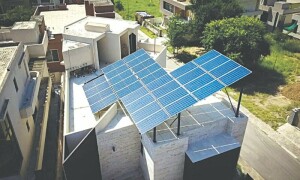FOR someone who was born and brought up in Karachi, I must confess the cultural distance between the metropolis and the hinterland exists not just in miles. The inhabitants of the city, especially as young and brash as Karachi, have built a hybrid identity from the experience of constant change, chaos and cultural interface.
Meanwhile, the people of the interior of Sindh, steeped in the folklore and poetry of its Sufis, zealously guard the purity of their language and interpret life through the prism of conventions shaped by ancient history.
What Pakistan, a county that brought together heterogeneous people from all over South Asia, has needed since its inception is an education policy to unify cultures through knowledge and respect for pluralism. While this dream of the founding fathers is forgotten in the midst of political volatility and confrontation, opportunities for reconciliation and an understanding of Pakistan's diverse traditions are lost.
As someone who was born in the decade that followed Partition, I grew up without the language skills to understand Bhitai and Bulleh Shah. It took a study of world cultures to feel the need to seek what was so close to me at Moenjodaro, Harappa, Sukkur, Taxila, Kohistan, Thar and Sibi.
A recent opportunity to visit Jamshoro, where I was invited to participate in the First International Art Seminar hosted by the Institute of Art and Design, Sindh University, led to three days of enriching dialogue.
To experience both intellectuals and fakir singers quoting Shah Latif's verse like a mantra, almost like a verbal and musical talisman not unlike the black thread that is rubbed on the 'sacred' instruments of the mendicants at the shrine of the great saint, it took the urban cynic in me some time to understand how deeply woven in the social and cultural fabric is the Sufi message. No theoretical text or debate can convey the intrinsic connection with a timeless philosophy that expresses the concerns of the people in a language that resonates in them.
A renewed optimism among the students and faculty at the Institute of Art and Design seems to have come with the new building that the department recently got after years of struggle. With it appeared a desire to build a bridge between received knowledge and the dynamic ideas of the new century.
The seminar seemed to set the tone for this change by creating space for debate and discussion on a wide range of issues that confront artists as national and international scholars read their papers.
The exchange with poets, writers, scholars, artists and journalists on the artist's role in society, however fundamental, was important in a society that exists on so many planes of social awareness. The multiple viewpoints presented by the participants communicated how art has moved from the linear thought process of modernism to a lateral embrace of visual culture which recognises context as a critical force.
It was refreshing to see the inclusion of two papers based on the field research of archeologists who are putting together fragments of the history of development of the image and its significance in prehistoric times. Dr Salim claimed the flint tools created from quartz in the Potohar Plateau were one of the earliest creative acts as the maker used his intelligence to select the material and then perfected a technique to craft its serrated edge.
Information on rock carving and cave drawings presented by Dr Ihsan Ali concentrated on the iconography of early man in Pakistan that art historians cannot ignore. The same was true of Dr Misbah Rasheed's study on the hybrid symbolic imagery of the ceramic mosaic murals at the Lahore Fort that has yet to be studied in depth and included in the art history curriculum which continues to be predominantly eurocentric.
Dr Ejaz Ikram's thought-provoking talk focused on the crisis of beauty in the world created by the de-linking of art from intuition, intellect and spirituality that were once responsible for the meditative harmony of Islamic art. According to him, since beauty rests not in innovation but the truth, he urged artists not to abandon tradition but to perfect it if they wanted to rediscover beauty.
Presenting an opposing view was the talk on European design presented by ceramist Maliha Paracha. She highlighted innovative ceramics by the Dutch company Droog that has gained worldwide reputation for its unusual and unpredictable designs that do not compromise functionality.
The artists' perspective at the seminar, among others, came from Sheherezade, the country's pioneer potter. With her exquisite visuals, she elaborated on the influence of historical and cultural Lahore on her personal and professional life. The labyrinth of the walled city, Mughal minars that dominate the skyline and the timeless skill of artisans that creates traditional pottery all combined to give her a sense of identity which, along with a global interface, has helped her develop a contemporary vocabulary which has won her global recognition.
This brings to my mind the renowned artist Mona Hartoum whose art is unique to her life. Hartoum, a Palestinian who grew up as a refugee in Lebanon, was stranded in London for a long period due to the war in Lebanon before she decided to pursue her art education in the UK. The trauma of displacement made her restless. According to her, she finds it difficult to stay in one place for too long. This angst is evoked in her work as ideas are translated through material to convey anxiety and restlessness.
Centrality of context was a common thread that ran through the papers. The message for the new entrants in the art community seemed to be that as they learned what constituted art in the studio, and while learning theory, they would also have to remember that the most powerful expression and strongest voice come from lived experience.
In the soul of Jamshoro dwell many untold stories, both ancient and modern. Artists just need to discover them.
asnaclay06@yahoo.com










































